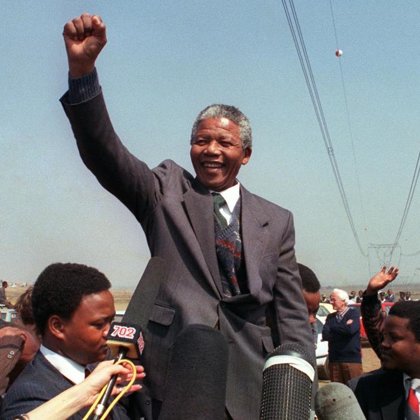NELSON MANDELA (1918 -2013) WAS A TRUE INTERNATIONALIST.HE WAS AN ANTI - APARTHEID HERO,HE SPENT 27 YEARS IN JAIL.MANDELA'S LIFE WAS KENNEDYESQUE IN IT'S COMBINATION OF GREAT POLITICAL ACHIEVEMENT AND HEARTBREAKING PERSONAL TRAGEDY.
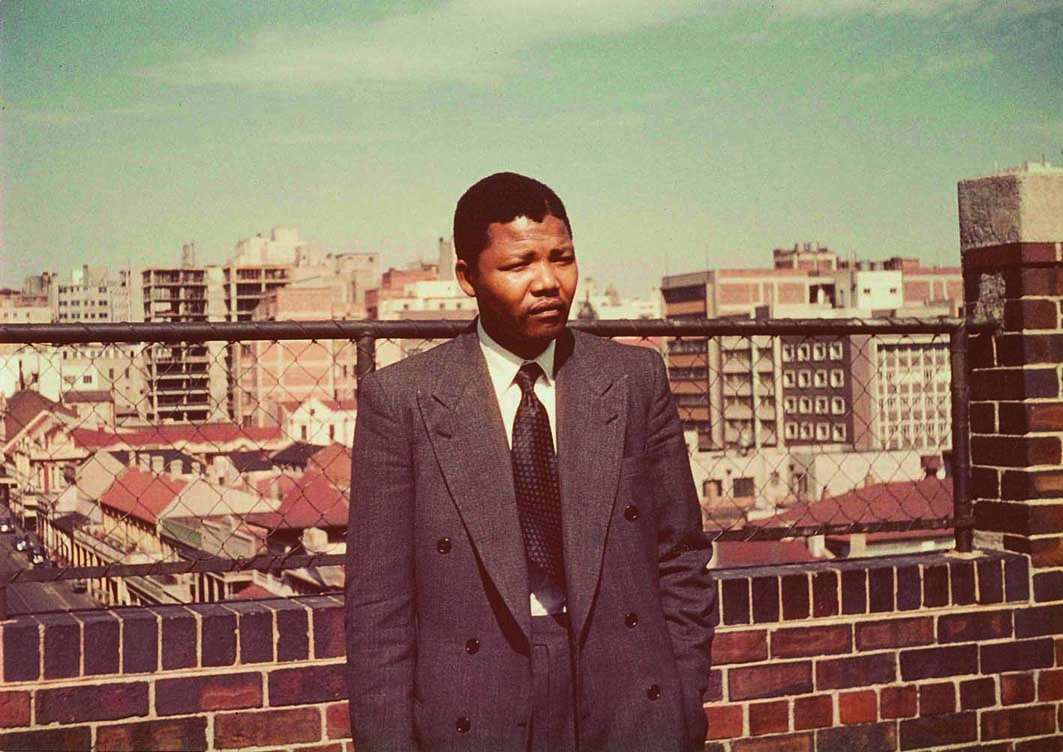 I have fought against white domination, and I have fought against black domination,” he told the court. “I have cherished the ideal of a democratic and free society in which all persons live together in harmony with equal opportunities. It is an ideal which I hope to live for, and to see realised. But, my Lord, if needs be, it is an ideal for which I am prepared to die.
I have fought against white domination, and I have fought against black domination,” he told the court. “I have cherished the ideal of a democratic and free society in which all persons live together in harmony with equal opportunities. It is an ideal which I hope to live for, and to see realised. But, my Lord, if needs be, it is an ideal for which I am prepared to die.
Nelson Mandela was born in Transkei, South Africa,he was a South African leader who spent years in prison for opposing apartheid, the policy by which the races were separated and whites were given power over blacks in South Africa. Upon his release from prison, Mandela became the first president of a black-majority-ruled South Africa in which apartheid was officially ended. A symbol of hope for many, Mandela is also a former winner of the Nobel Peace Prize.Nelson Rolihlahla Mandela is the son of Nonqaphi Nosekeni and Henry Mgadla Mandela, a chief and chief councillor to the paramount chief of the Thembu and a member of the Madiba clan.Mandela’s middle name is Rolihlahla, which literally means ‘pulling the branch of a tree’, or colloquially, ‘troublemaker’. His was given the name Nelson by his white missionary school teacher.In 1930 when his father died, Mandela was placed under the care of his father’s cousin, David Dalindyebo, the acting paramount chief of the Thembu. Mandela was the first member of his family to attend high school and when he matriculated at Healdtown Methodist Boarding School in 1938 he formed part of a very small number of black pupils who had attained a high school education in the country.The patronage of Mandela’s relative the paramount chief resulted in Mandela joining the chief’s sons, Justice when they were sent to the only university for Blacks (African, Coloured and Indian) at Fort Hare near Alice in the Eastern Cape. At Fort Hare, Mandela befriended African, Indian and Coloured students, many of whom went on to play leading roles in the South African liberation struggle and in the anti-colonial struggle in some African countries. One of Mandela’s fellow students was Oliver Tambo. They would become business partners, close comrades and lifelong friends.Mandela did not complete his degree at Fort Hare. He was involved in a dispute related to elections of the Student Representative Council. Mandela refused to take his seat on the council because he disagreed with the way the elections were run. After he rejected the university’s ultimatum to take the seat to which the was elected or face expulsion, the university gave him until the end of the student holidays to think the matter through, but he felt there were principles at stake that could not be compromised. He informed his guardian that he was not going back to Fort Hare and stubbornly stood his ground when the Regent, Jongintaba, pleaded with him. In 1944 Mandela joined the African National Congress (ANC) and soon became part of a group of young intellectuals that included Walter Sisulu, Oliver Tambo, Anton Lembede, and Ashley Mda. The group articulated its dissatisfaction with the way the ANC was being run, critiqued its policy of appeasement, and became the driving force in the formation of the ANC Youth League (ANCYL) in April of the same year. Influenced by the militant action of the Natal and Transvaal Indian Congresses’ Passive Resistance campaign of 1946 and the mineworkers strike, the ANC Youth League began drafting what came to be known as the Programme of Action for the ANC.
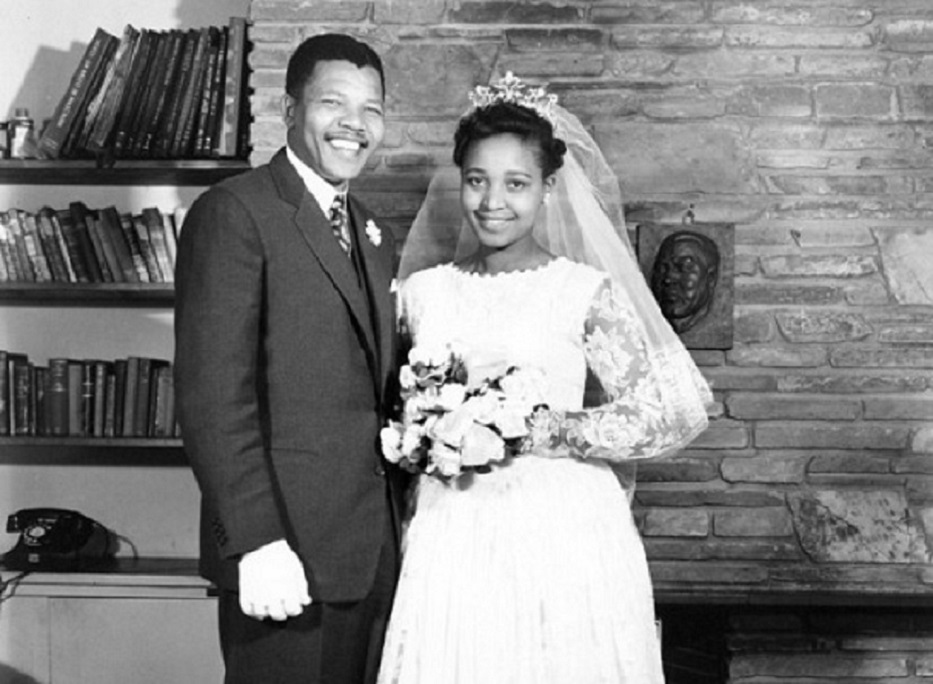
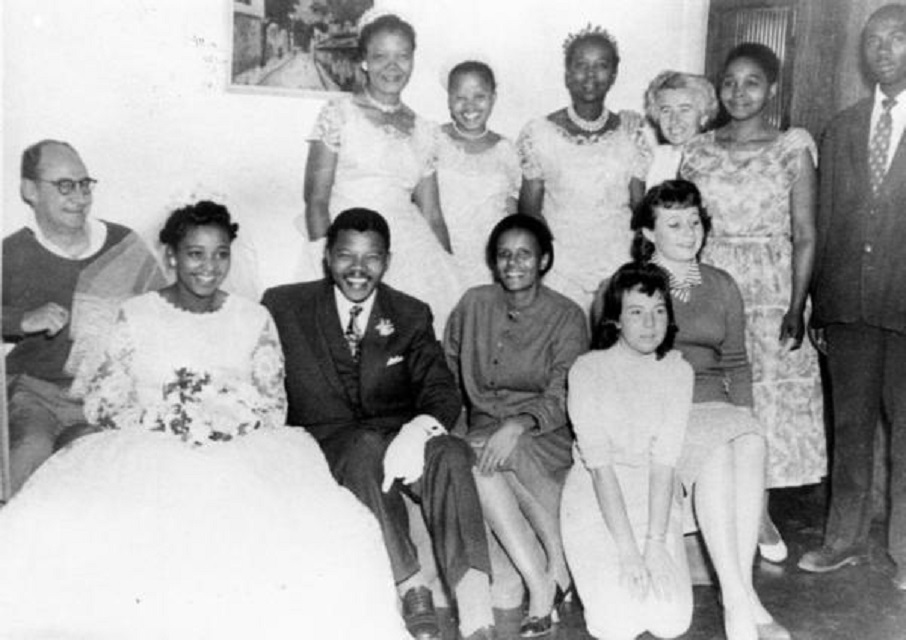 In 1957, at a low ebb in Mandela’s political career, when the trial was diverting his attention from the split in the ANC, he met Winnie Madikizela, a 23-year-old social worker at Baragwanath hospital. Winnie was ambitious, strong-willed, pugnacious (as a girl she had manufactured a vicious knuckle duster for use on her sister), smartly turned out and very attractive. Mandela married her on June 14 1958.
In 1957, at a low ebb in Mandela’s political career, when the trial was diverting his attention from the split in the ANC, he met Winnie Madikizela, a 23-year-old social worker at Baragwanath hospital. Winnie was ambitious, strong-willed, pugnacious (as a girl she had manufactured a vicious knuckle duster for use on her sister), smartly turned out and very attractive. Mandela married her on June 14 1958.
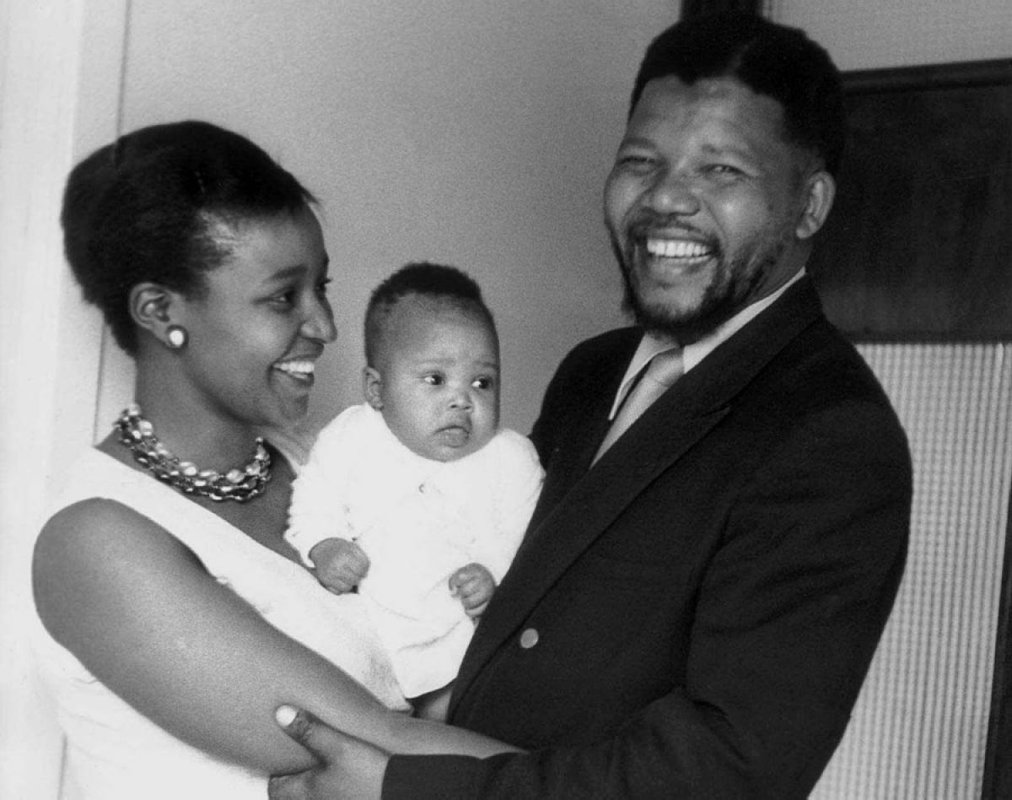 Nelson Mandela with his wife Winnie and daughter Zindzi, 1961.Nelson and Winnie Mandela show off their firstborn daughter, Zindzi, at their home in Orlando West, Soweto in 1961.
Nelson Mandela with his wife Winnie and daughter Zindzi, 1961.Nelson and Winnie Mandela show off their firstborn daughter, Zindzi, at their home in Orlando West, Soweto in 1961.
Mandela married his first wife, Evelyn Mase in 1944, the same year he co-founded the African National Congress Youth League.She confessed to longtime friend Fatima Meer that "I think I loved him the first time I saw him." Working as a nurse, she supported him as he completed his law studies. Their first years together as newlyweds sound like typical marital bliss — raising their three little babies and cooking meals together. But Evelyn soon became resentful of her husband's increasingly noticeable absences.Anthony Sampson, a close friend of Mandela and his official biographer, claims that he was a charismatic "ladies man" and even flaunted his female "political colleagues" in front of Evelyn. "There was another woman and this one started coming home, walking into our bedroom, following him into the bathroom," Evelyn claimed. "I declared that I would not allow it." Rumor has it that Mandela even fathered an illegitimate son by his secretary, Ruth Mompati, around this time. It was enough to Evelyn. They finally divorced in 1958 and she returned to the Transkei where she ran a shop. In a later interview, she remarked bitterly, "How can a man who has committed adultery and left his wife and children .The whole world worships Nelson too much. He is only a man."Despite their strife, when she died, Mandela attended the funeral in Johannesburg alongside his second and third wives.In 1957, at a low ebb in Mandela’s political career, when the trial was diverting his attention from the split in the ANC, he met Winnie Madikizela, a 23-year-old social worker at Baragwanath hospital. Winnie was ambitious, strong-willed, pugnacious (as a girl she had manufactured a vicious knuckle duster for use on her sister), smartly turned out and very attractive. Mandela married her on June 14 1958.They had no more than four months together before Mandela was imprisoned. But the honeymoon phase was short and sweet. Soon after saying "I do", she was arrested for an incendiary speech, prompting Mandela to remark proudly, "I think I married trouble." It was then that Mandela was sent to prison. Over the next 27 years, from his jail cell on Robben Island, he penned loving letters to Winnie. In his book, Long Walk To Freedom, he wrote: "My dearest Winnie, your beautiful photo still stands about two feet above my left shoulder as I write this note. I dust it carefully every morning, for to do so gives me the pleasant feeling that I'm caressing you as in the old days. I even touch your nose with mine to recapture the electric current that used to flush through my blood whenever I did so."In the coming years, Winnie would be in and out of jail herself. And despite the love letters and prison visits, it was political strife and alleged affairs on Winnie's part that eventually drove a wedge between the couple. They divorced in 1996.Winnie Mandela joined the political struggle with gusto. Late in 1958, heavily pregnant, she was arrested for her part in protests against the pass laws, and held in prison for some weeks. The Mandelas’ daughter Zenani was born on February 4 1959, soon after Winnie had been freed. By the time that Mandela was acquitted of treason in March 1961, he was already involved in the next stage of the struggle. By then, the Sharpeville massacre and the formal banning of the ANC in 1960 had robbed peaceful resistance of all credibility. After a series of new mass demonstrations was launched, Mandela was a marked man. He was on the run for 17 months, earning the nickname “The Black Pimpernel” for his use of disguise, whether as a garage mechanic, caretaker, priest, window-cleaner or messenger. In these circumstances, he created Umkhonto we Sizwe (Spear of the Nation), the armed wing of the ANC, which carried out acts of sabotage.Mandela had disappeared from view in 1964 after giving a four-hour speech at the conclusion of his sabotage trial, where he was convicted and received a life sentence. He was a rugged young man in his 40s, a former boxer who had full cheeks, a beard and mustache and was always dressed in a suit at his court appearances.He spent most of his prison term on Robben Island, South Africa's version of Alcatraz. On this island fortress, Mandela often labored at a limestone quarry during the day, where the glaring sun harmed his eyes. At night, he could see the twinkling lights of Cape Town in the distance. The damp conditions on the island likely contributed to the tuberculosis he contracted.In January 1962 Mandela left South Africa for the first time, escaping across the border into Bechuanaland, now Botswana. His ostensible purpose was to attend a conference of the Pan-African Freedom Movement in Addis Ababa, but he also seized the occasion to make a tour of African states in order to raise funds, and to look for sources of weapons and training. Afterwards, Mandela went on to Egypt, Libya, Tunisia, Morocco, Mali, Guinea, Sierra Leone, Liberia, Ghana and Senegal. From Dakar he took a plane to London, where he met Hugh Gaitskell, the leader of the Labour Party, and Jo Grimond of the Liberals. There is a photograph of him standing outside Westminster Abbey, a reminder that he always considered the British Parliament as the original fountain of democracy.
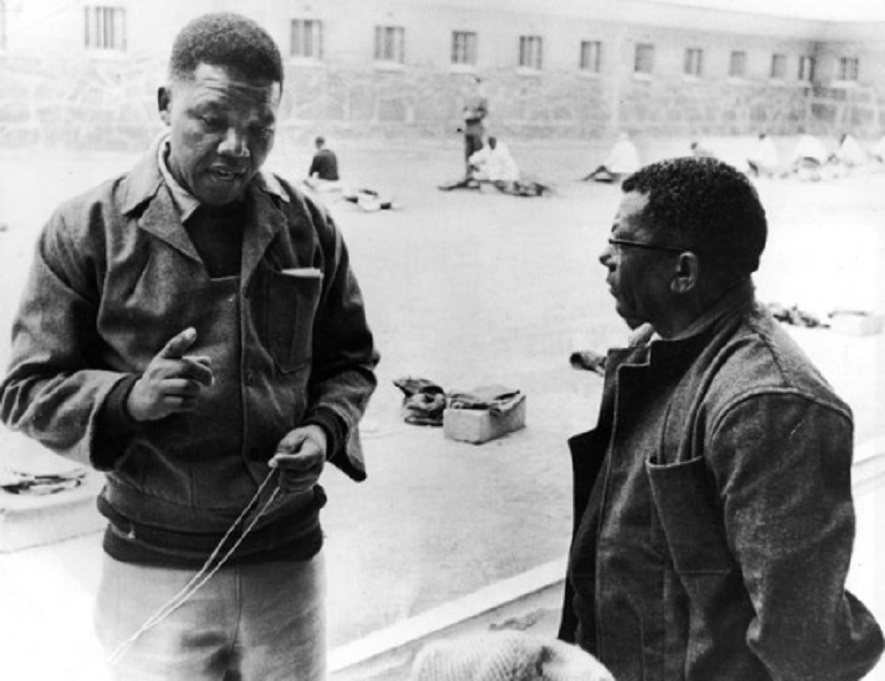 Mandela once said, “In prison, you come face to face with time. There is nothing more terrifying.” To learn that he refused release after 27 years of incarceration, despite the terror of it, is more proof of Mandela’s unwavering pursuit of justice.In 1962, Mandela was arrested, convicted of sabotage and conspiracy to overthrow the government, and sentenced to life imprisonment in the Rivonia Trial. He was imprisoned for nearly 20 years on Robben Island until a 1982 transfer to Pollsmoor Prison. Perhaps (?) another lesser known fact is that Mandela was a keen boxer. He boxed to maintain health and discipline, so I’ve included a couple of images of Mandela training — one from 1950 before his imprisonment (below) and one from a prison yard.
Mandela once said, “In prison, you come face to face with time. There is nothing more terrifying.” To learn that he refused release after 27 years of incarceration, despite the terror of it, is more proof of Mandela’s unwavering pursuit of justice.In 1962, Mandela was arrested, convicted of sabotage and conspiracy to overthrow the government, and sentenced to life imprisonment in the Rivonia Trial. He was imprisoned for nearly 20 years on Robben Island until a 1982 transfer to Pollsmoor Prison. Perhaps (?) another lesser known fact is that Mandela was a keen boxer. He boxed to maintain health and discipline, so I’ve included a couple of images of Mandela training — one from 1950 before his imprisonment (below) and one from a prison yard.
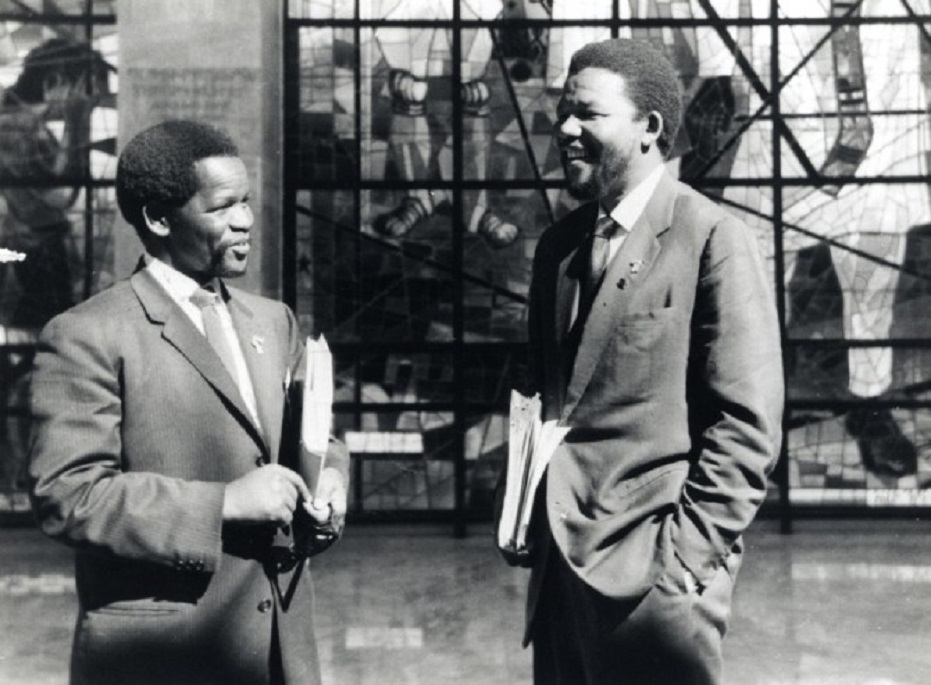 Oliver Tambo (left) was among the founding members of the African National Congress Youth League in 1944 and became its first national secretary.Tambo, born in Bizana, was among the founding members of the African National Congress Youth League in 1944 and became its first national secretary. He later became president of the ANC.
Oliver Tambo (left) was among the founding members of the African National Congress Youth League in 1944 and became its first national secretary.Tambo, born in Bizana, was among the founding members of the African National Congress Youth League in 1944 and became its first national secretary. He later became president of the ANC.
On 31 January 1985, Botha, speaking in parliament, offered Mandela his freedom on condition that he ‘unconditionally rejected violence as a political weapon’. This was the sixth such offer, earlier ones stipulating that he accept exile in the Transkei. His daughter Zinzi read Mandela’s reply to this offer to a mass meeting in Jabulani Stadium, Soweto, on 10 February, 1985. This was the text of his response as read publicly by Zinzi:I am a member of the African National Congress. I have always been a member of the African National Congress and I will remain a member of the African National Congress until the day I die. Oliver Tambo is much more than a brother to me. He is my greatest friend and comrade for nearly fifty years. If there is any one amongst you who cherishes my freedom, Oliver Tambo cherishes it more, and I know that he would give his life to see me free. There is no difference between his views and mine.I am surprised at the conditions that the government wants to impose on me. I am not a violent man. My colleagues and I wrote in 1952 to Daniel François Malan asking for a round table conference to find a solution to the problems of our country, but that was ignored. When [Johannes Gerhardus] Strijdom was in power, we made the same offer. Again it was ignored. When Hendrik Verwoerdwas in power we asked for a national convention for all the people in South Africa to decide on their future. This, too, was in vain.It was only then, when all other forms of resistance were no longer open to us, that we turned to armed struggle. Let Botha show that he is different to Malan, Strijdom and Verwoerd. Let him renounce violence. Let him say that he will dismantle apartheid. Let him unban the people’s organisation, the African National Congress. Let him free all who have been imprisoned, banished or exiled for their opposition to apartheid. Let him guarantee free political activity so that people may decide who will govern them.I cherish my own freedom dearly, but I care even more for your freedom. Too many have died since I went to prison. Too many have suffered for the love of freedom. I owe it to their widows, to their orphans, to their mothers and to their fathers who have grieved and wept for them. Not only I have suffered during these long, lonely, wasted years. I am not less life-loving than you are. But I cannot sell my birthright, nor am I prepared to sell the birthright of the people to be free. I am in prison as the representative of the people and of your organisation, the African National Congress, which was banned.What freedom am I being offered while the organisation of the people remains banned? What freedom am I being offered when I may be arrested on a pass offence? What freedom am I being offered to live my life as a family with my dear wife who remains in banishment in Brandfort? What freedom am I being offered when I must ask for permission to live in an urban area? What freedom am I being offered when I need a stamp in my pass to seek work? What freedom am I being offered when my very South African citizenship is not respected?Only free men can negotiate. Prisoners cannot enter into contracts. Herman Toivo ja Toivo, when freed, never gave any undertaking, nor was he called upon to do so. I cannot and will not give any undertaking at a time when I and you, the people, are not free.Your freedom and mine cannot be separated. I will return.
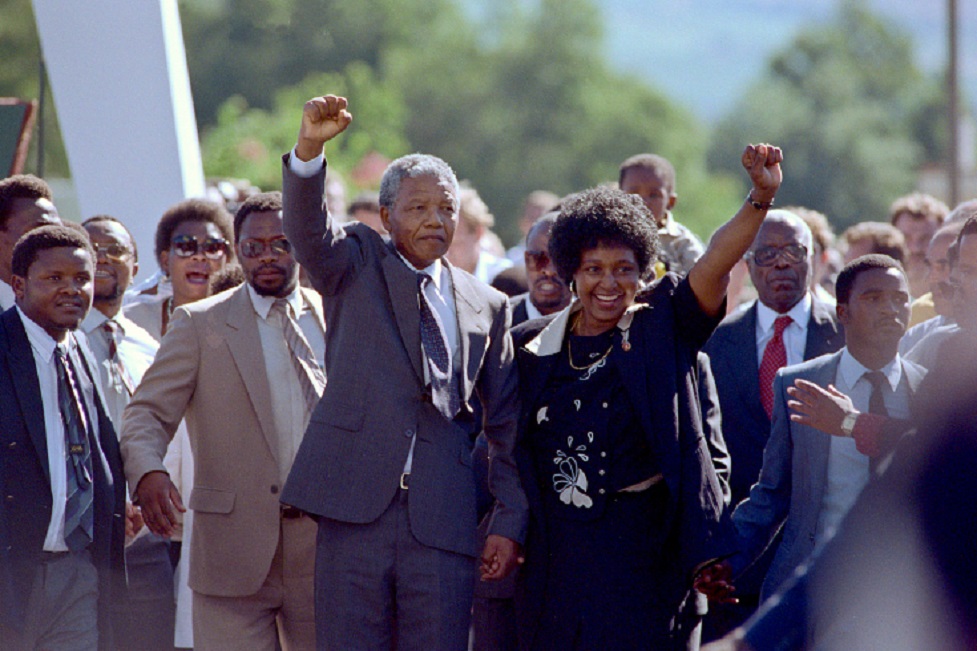 Nelson Mandela walks out of Victor Verster prison after 27 years of imprisonment on Feb 11, 1990, Cape Town, Western Cape, South Africa. Nelson Mandela (left) and Winnie Mandela with fist raised. Nelson Rolihlahla Mandela is known worldwide for his struggle to overthrow white racism in South Africa for 50 years (1944-1994) and winning the Nobel Peace Prize for his efforts. He spent 27 years in prison from 1962- to 1990, and finally became the first black president of the country, bringing a unified and democratic South Africa.
Nelson Mandela walks out of Victor Verster prison after 27 years of imprisonment on Feb 11, 1990, Cape Town, Western Cape, South Africa. Nelson Mandela (left) and Winnie Mandela with fist raised. Nelson Rolihlahla Mandela is known worldwide for his struggle to overthrow white racism in South Africa for 50 years (1944-1994) and winning the Nobel Peace Prize for his efforts. He spent 27 years in prison from 1962- to 1990, and finally became the first black president of the country, bringing a unified and democratic South Africa.Nelson Mandela was released unconditionally from prison after 27 years. Accompanied by his then-wife Winnie, he left the Victor Verster prison on the outskirts of Paarl and was driven the 60 kms to Cape Town by African National Congress'(ANC) Rose Sonto along a route lined by thousands of supporters.On the balcony of the City Hall he spoke to a crowd of approximately 50 000 people, who had waited for hours to see him. He started by expressing his sincere and warmest gratitude to the "millions of my compatriots and those in every corner of the globe who have campaigned tirelessly for my release".Mandela's release followed the relaxation of apartheid laws - including the unbanning of leading liberation organisations (e.g. ANC, SACP, PAC) by then South African President FW de Klerk. In commemoration of his release, people across the country danced joyously in the streets. Unfortunately the revelry also caused some problems, as doctors had to treat over a hundred people as police clashed with youths looting shops in various cities and townships. In Mdantsane, Ciskei, 10 people were killed when Ciskei soldiers used force against a group of revellers celebrating this liberation figure's release. Mandela’s release can be seen as the beginning of the new South Africa.The evening before his release from 27 years in prison, Nelson Mandela was ushered into a secret meeting with South African President F.W. de Klerk for a conversation that sounded straight from the theater of the absurd.De Klerk told Mandela he would be a free man the next day, making good on a pledge the president had made a week earlier, though without setting the exact date. Yet Mandela was still caught off guard."I deeply wanted to leave prison as soon as I could, but to do so on such short notice would not be wise," Mandela wrote later in his autobiography, Long Walk To Freedom. "I thanked Mr. de Klerk, and then said that at the risk of appearing ungrateful I would prefer to have a week's notice in order that my family and my organization could be prepared."Taken aback, de Klerk excused himself to consult with his advisers. Several minutes later, he returned and insisted that Mandela, like a house guest who had hung around too long, would have to check out the next day whether he liked it or not. Mandela relented, and the jailer and the jailed shared a glass of whiskey.Less than two years after divorcing Winnie, Mandela was dating his soon-to-be third and last wife, Graca Machel.When her husband tragically died in an air crash, leaving her widowed, Mandela wrote to Graca from prison. She was still in mourning when they met in person in 1990, but two years later, Mandela became the godfather of her stepchildren. Mandela was in love again, gushing to reporters, "Late in life, I am blooming like a flower because of the love and support she has given me." On July 18, 1998 — his 80th birthday — Graca broke her vow that she would not marry another president.She famously got along well with ex-wife Winnie. "I call her little sister and she calls me big sister, we share everything," Winnie said . "When she talks to me, she talks about 'our husband'." They were both by his side in his final days.Throughout 2012 and 2013 rumours abounded about Mandela's failing health until the nation's worst fears were confirmed on 5 December 2013. Mandela had passed away in Houghton Estate in Johannesburg. His memorial service was held 15 December in the FNB Stadium, Johannesburg and was attended by 91 sitting heads of state and a number of other dignitaries.
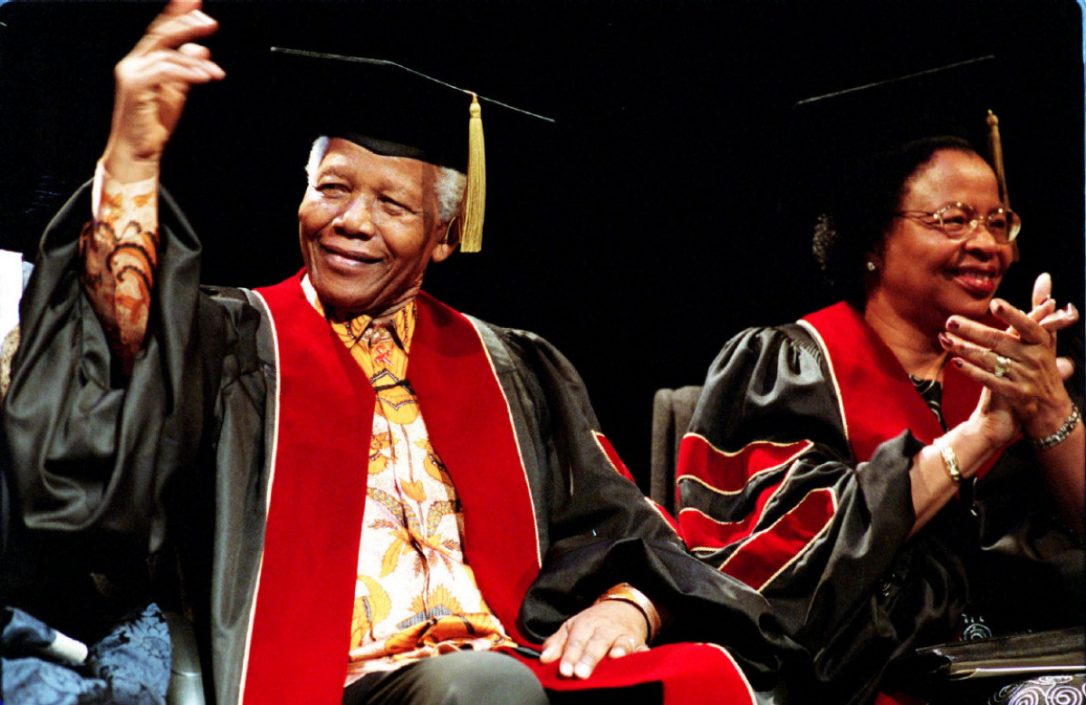 Nelson Mandela and his wife Graca Machel receive honary doctorates at Ryerson University in November 2001.The day after Nelson Mandela was released from prison in South Africa, the Canadian government invited the freedom fighter to Canada. Honoured by our commitment to his struggle, he would visit three times.
Nelson Mandela and his wife Graca Machel receive honary doctorates at Ryerson University in November 2001.The day after Nelson Mandela was released from prison in South Africa, the Canadian government invited the freedom fighter to Canada. Honoured by our commitment to his struggle, he would visit three times.

